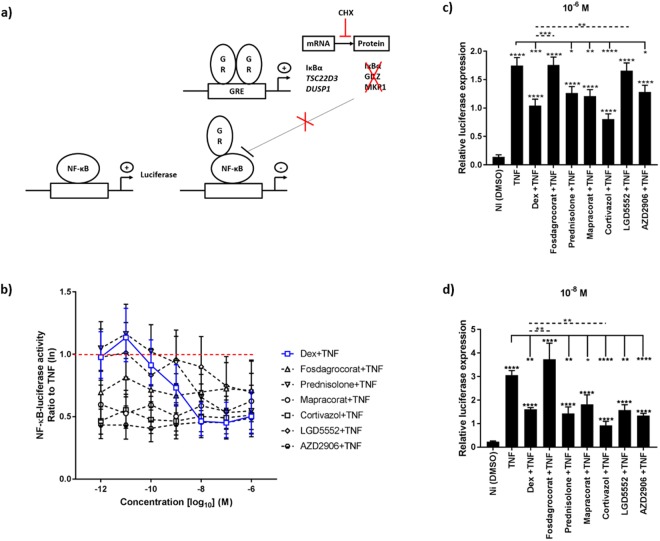Figure 3.
GR dimer-favoring compounds still support transrepression of NF-κB in the absence of de novo protein synthesis. (a) Schematic overview of the NF-κB-luciferase and cycloheximide (CHX) principle. (b) NF-κB-luciferase activity. A549 NF-κB-luc cells were pretreated with a concentration range of the compounds (1 h), followed by challenge with 1000 U/ml hTNF for 5 h, after which they were lysed and luminescence was read out. The graph represents the ratio to TNF (red dotted−). (c,d) NF-κB-luciferase gene expression. A549 NF-κB-luc cells were pretreated with 10 µg/ml CHX (30 min), followed by stimulation with 10−6 M (c) or 10−8 M (d) of the compounds. After 1 h, the cells were challenged with 1000 U/ml hTNF for 2 h. Data are shown as mean ± SEM. A Hierarchical Generalized Linear Mixed Model (HGLMM) was fitted to the luciferase activities (measured at various concentrations of the compounds) and to the expression data. T statistics (unpaired, two-tailed) were used in (b) to assess the significance of fixed compound and concentration effects estimated as differences (on the transformed scale) to Dex at a particular concentration set as reference, in (c,d) to assess the significance of fixed compound effects estimated as differences (on the transformed scale) to NI (significances above error bars), TNF (indicated with−) or Dex (indicated with dotted−) set as reference. Estimated mean values were obtained as predictions from the HGLMM, formed on the log scale (b) or on the scale of the response variable (c,d). To minimize graph complexity in (b) statistical differences are listed in Supplemental Table S6. P-values < 0.05, 0.01, 0.001 and 0.0001 are represented by *, **, *** or **** respectively. Non-significant differences are not indicated on the graph. Experiments were repeated at least twice with at least two technical replicates included. NI: Non-Induced, TNF: Tumor Necrosis Factor, Dex: Dexamethasone, GR: Glucocorticoid Receptor, GRE: Glucocorticoid Responsive Element.

